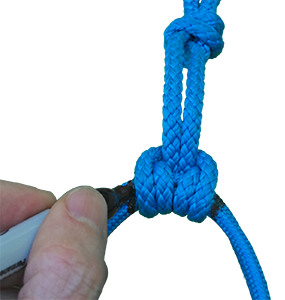 |
| The local rock monkeys work'n the Gstrings on the Gallows prototype |
Some users have mentioned that it's a challenge to consistently set the Gstrings back to the exact same position used in the last training session. While it can be done by trial and error, the following method can help aid this process and make it simpler, quicker and more consistent.
For example, say you're training on the crimpers. Since the rotation of the grips determines the difficulty of the crimp (because they're ellipses and contact area varies), it's important that you get the grips consistently back to the same angle so that you're training the same degree of difficulty each session.
When you find a grip position that you'd like to train, hang the grip and double check that it's the exact angle you desire, then tighten the Prussik knot. Take the grips down and use a fine or medium tip marker and put marks along both sides of the Prussik knot on the cords of the 3D-Sling like this:
This will result in four small marks - two on each side of the Prussik knot:
Take the second grip and adjust it so that it hangs exactly the same as the first one. Then mark it like you did the first grip.
Now when you change the grips to different positions, you'll see four marks along the 3D-Sling that should look like this:
Whenever you desire to return to the grips to the previous position you were training, you'll have these marks as reference points to set the grips back to that position. It's simple to loosen the Prussik knot and slide the hang loop back and forth along the 3D-Sling until the marks line up with two on each side of the Prussik knot just as had when you first marked them. The grip will hang at exactly the same angle as before:
If you want to mark several different grip positions, it could become confusing with several sets of marks all the same color. If you find yourself in that situation, you may want to use different color markers for each position. For example: black for one position, red for another, dark blue for another, and green for another.
As you continue to sue them over time, you may find that it becomes easier to adjust them and that you rely less on the marks. However, if you're into a serious training program where it's critical to have them set exactly the same as before, the marks will enable you to consistently do that.
As you continue to sue them over time, you may find that it becomes easier to adjust them and that you rely less on the marks. However, if you're into a serious training program where it's critical to have them set exactly the same as before, the marks will enable you to consistently do that.




